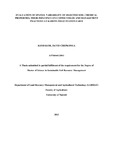| dc.description.abstract | ABSTRACT
Coffee production in Kenyan farms (smallholder and plantations) has been on the decline
over the last two and half decades in output and quality and this may have been due to
declining soil productivity arising from none or minimal soil amelioration. The same trend is
reflected at Kabete Field Station coffee farm. Soil varies with land uses from location to
location and determination of the extent of spatial variation of soil properties within the farm
is key in the evaluation of management practices to be put in place. The spatial variation in
soil chemical properties at Kabete Field Station coffee farm which has been under coffee for
the last 83 years had not been investigated. To assess and profile soil fertility status of Kabete
Field Station Coffee Farm for site-specific input use for improvement of coffee production, a
within field spatial variability of soil chemical parameters and coffee yield was evaluated in
four of the eight coffee fields in the farm. The fields were divided into 50 m X 60 m
rectangular plots in which 122 geo-referenced grid-point soil samples were collected from
two depths (0-15cm and 15-30cm) where coffee plant feeder roots extract most nutrients.
This study was carried out with the objectives to (i) documenting past and current coffee
management practices in use at the farm (ii) to investigate, and profile spatial variability of
selected soil chemical properties that influence yield and quality of coffee and (iii) to relate
these soil characteristics to coffee yields at the farm. The study examined seven consecutive
years of farm operations (2005-2012) through records kept on coffee management practices
for evidence-based documentation of various coffee production activities at each stage and
compared it with best practice recommended by Coffee Research Foundation (CRF). Grid
point sampling scheme was adopted for better characterization and detection of patterns in
variability of soil properties within the coffee fields. Grid point soil sampling scheme was
carried out for intensive soil and crop information as a baseline for precision coffee farming
in the farm. The Geo-referenced soil samples were analyzed for variation in total nitrogen,
xiv
available phosphorus, exchangeable potassium at primary macro level and calcium and
magnesium at secondary macro levels. Observations from the records studied showed that
although the farm is ecologically ideal for coffee production, there was significant divergence
in observance of good agricultural best practice resulting in low coffee yield of 0.27 ton ha-1
compared to 1.43 ton ha-1 obtained by neighbouring coffee farm, Kamundu estate within the
same agro-ecological zone. The performance of the farm on the whole stood at 34 % of the
achievable optimum potential in the minimum above 1.3 ton ha-1. The soil analysis results
showed that soil pH was within the required range (4.4 – 5.4) but on the upper sufficiency
levels. Available phosphorus (P) was critically low (1 – 10 ppm) compared to adequate level
for coffee plant (20 – 100ppm). This may have affected the uptake of the other mineral
nutrients by the coffee as the root mass could be severely compromised. Since P is low,
response to phosphate fertilizer application may be expected.GIS spatial analysis to examine
within field yield influencing factors showed that organic carbon, total nitrogen and
exchangeable calcium influenced yield positively. Multivariate analysis showed that the
selected soil chemical properties contributed significantly to the yield as yield-determining
factors explaining as much as 91.7 % in F1, 37.1 % in F2a, 32% in F7 and 67.5 % in F20 of
the spatially structured or non-random variation of the coffee yield. The spatial variation
showed in the distribution of yield determining factors provides opportunity for site-specific
application of inputs according to the available quantities in the soil through guided
application to save costs and increase nutrient efficiency. | |

